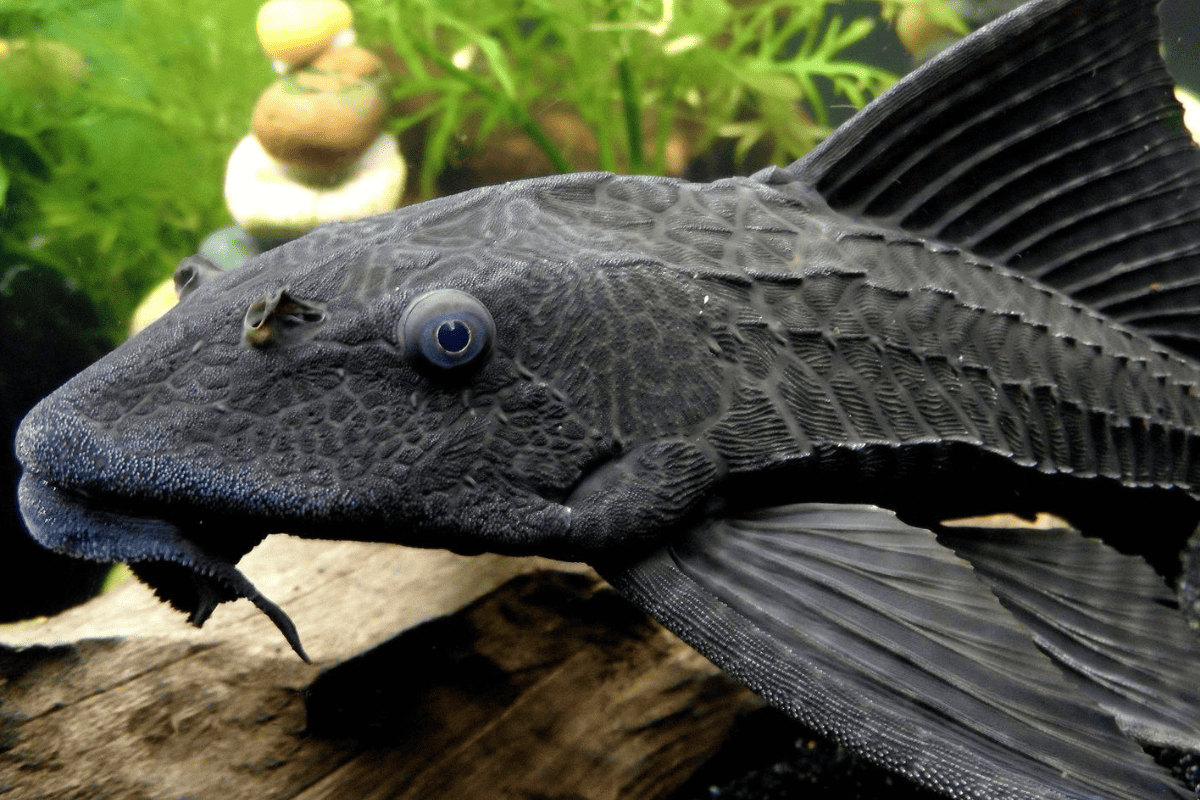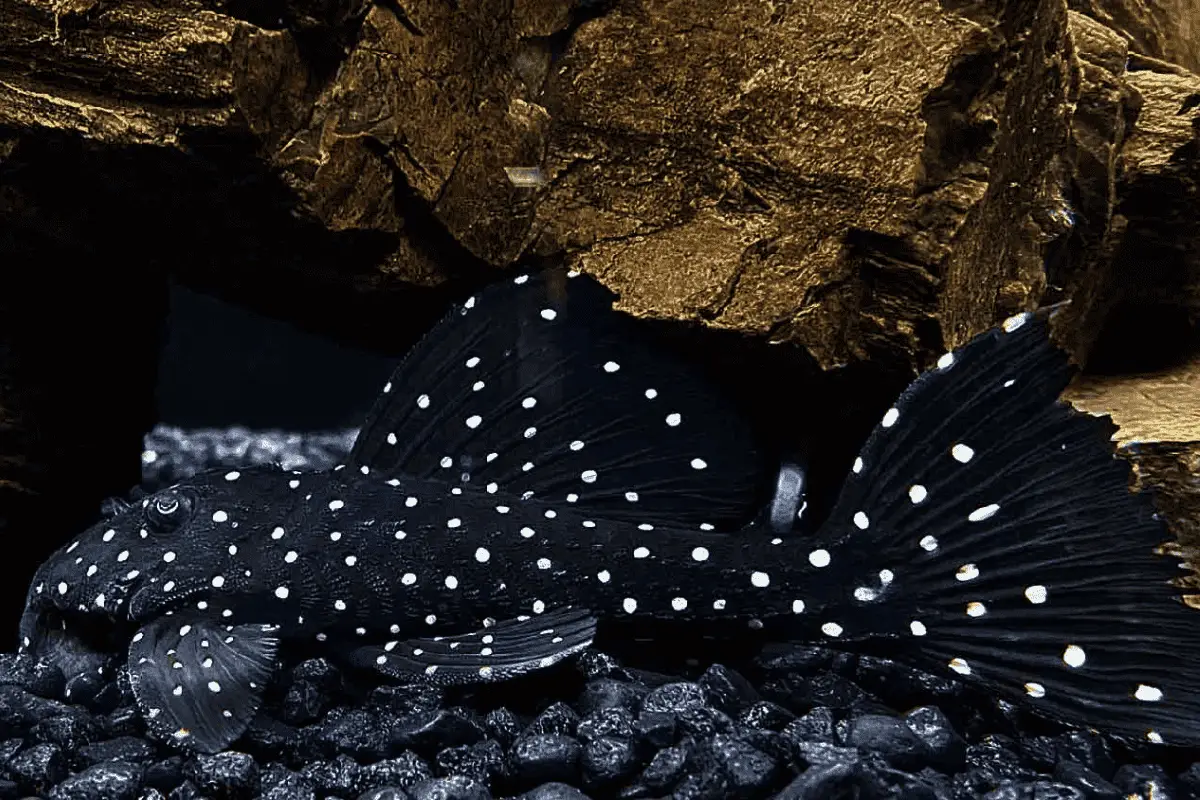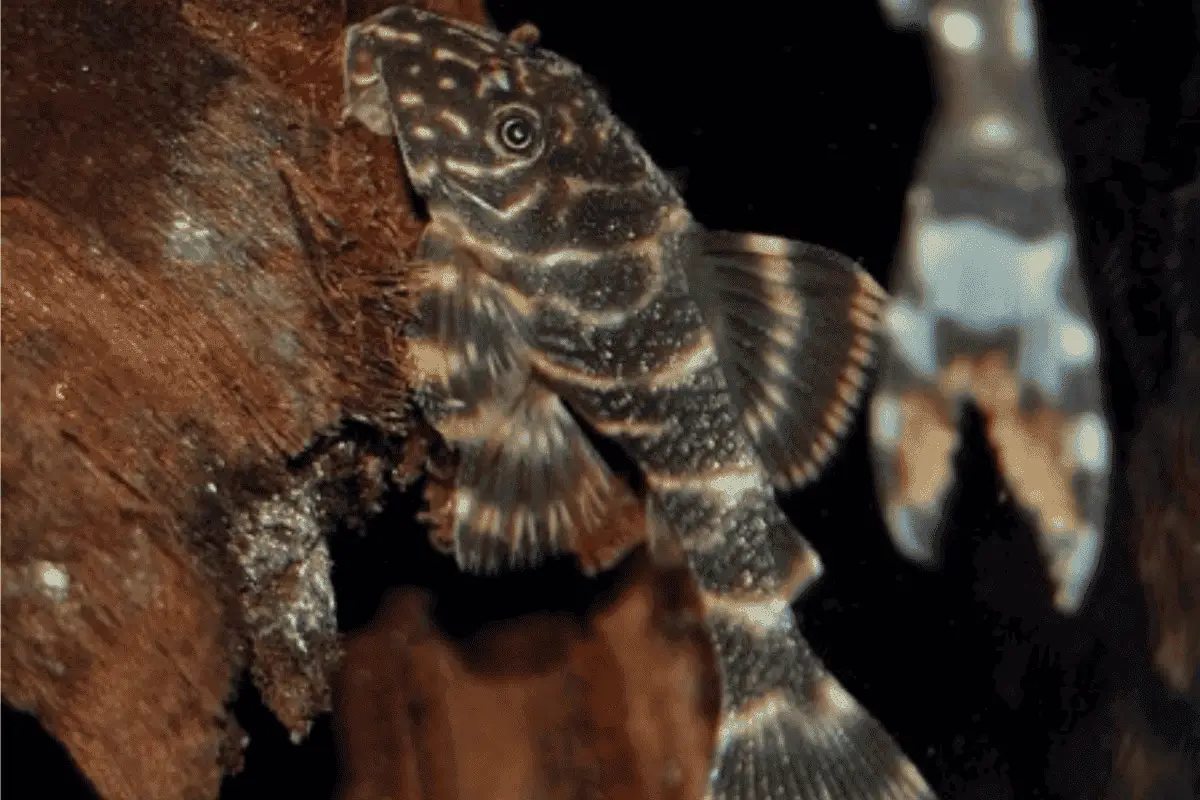Plecos are pretty versatile – there are over 150 species, each with its own characteristics. This fact makes it difficult for fish owners to estimate what size their Pleco would reach.
Knowing about the growth rate, size, and stages of your Pleco is essential, as it helps you adjust the tank size and its surroundings.
Here, I’ll focus on the most common 15 Pleco species, answer how fast they grow, how long it takes for them to grow, what size they ultimately reach, and more.
Let’s dive right into it.
What Are the Pleco Fish Growth Stages?
Here’s a simple table outlining the growth stages of Plecos and their corresponding age durations:
| Growth Stage | Age Duration |
| Fry | Hatching – Few Weeks |
| Juvenile | Few Weeks – 6-8 Months |
| Sub-adult | 8 Months – 1.5-2 Years |
| Adult | 2 Years – 6 Years |
| Senior | 6 Years Onward |
Also Read: Pleco Fish Facts
1. Fry

Pleco fry are the very young, recently hatched stage, typically aged from hatching up to a few weeks old.
These tiny, delicate creatures require special care and attention to ensure healthy growth.
- Size and Appearance: Pleco fry are tiny, often just a few millimeters in length, and might resemble small transparent worms more than their adult counterparts.
- Dietary Needs: At this stage, Plecos primarily consume microorganisms and infusoria, requiring specialized foods or finely crushed flake food for nourishment.
- Vulnerability: Fry are more susceptible to changes in water conditions and predators, so they benefit from being in a protected breeding or nursery tank for safety.
Also Read: Pleco Fry 101
2. Juvenile

The juvenile stage of Plecos, spanning from a few weeks to around 6-8 months, sees a noticeable increase in size and development of distinctive features.
This is when they begin to resemble the adult form but are still considerably smaller.
- Size and Features: Juvenile Plecos are still small, typically between 2 to 4 inches, but show more defined features like sucker mouths and patterned skin.
- Diet Shift: As Plecos grow, their diet expands to include algae, vegetables, and sinking pellets, reflecting their natural scavenger behavior in the wild.
- Habitat Needs: Juveniles can be more active and might need larger spaces, good hiding spots, and stable water conditions to thrive.
3. Sub-adult

When Plecos reach the sub-adult stage, usually from 8 months to about 1.5-2 years, they’re in their teenage phase. They are nearing their full size but are not yet fully mature.
- Size and Maturity: Sub-adult Plecos are often between 4 to 8 inches, depending on the specific species, and their features are more pronounced and distinctive.
- Dietary Variety: These Plecos continue to eat algae and pellets but can also enjoy treats like blanched vegetables, and they might start showing preferences.
- Behavioral Changes: Sub-adult Plecos might display territorial behaviors, so it’s essential to monitor tank mates and ensure there’s enough space for everyone.
4. Adult

Once Plecos reach the adult stage, typically from about 2 to 6 years, they’re at their prime.
They display their full size, colors, and patterns, exhibiting the traits that many aquarists admire and seek.
- Full Size Attained: Adult Plecos can range widely in size, from 4 inches in smaller species to over 24 inches in the larger ones. Their size largely depends on their specific species and tank conditions.
- Diet Stabilizes: At this stage, Plecos have a well-established diet that includes algae, pellets, and occasional treats. Consistent, high-quality nutrition is key to maintaining their health and vibrancy.
- Breeding Potential: Adult Plecos, if kept in appropriate conditions with potential mates, might display breeding behaviors. Providing caves or secluded spots can encourage spawning.
5. Senior

As Plecos age beyond their prime adult years, usually from 6 years onward, they transition into their senior phase.
While they’re still robust, they might show signs of aging, and their care needs might change a bit.
- Signs of Aging: Senior Plecos can have faded colors or less vibrant patterns. They might also have more wear and tear on their fins or bodies due to age.
- Dietary Adjustments: Older Plecos may have different dietary needs, potentially requiring softer foods or supplements to support their health as their metabolism slows.
- Health Monitoring: It’s crucial to monitor senior Plecos for any health issues. Regular checks and ensuring pristine water conditions can help prolong their lifespan and ensure comfort in their golden years.
How Big Do Plecos Get?
Plecos exhibit a wide range of sizes depending on the specific species.
While some species stay relatively small at around 4-6 inches, others can grow impressively large, reaching up to 24 inches or more in length.
Here’s a table showcasing the sizes of some of the most common Plecos species kept in aquariums:
| Pleco Species | Size |
| Common Pleco (Pterygoplichthys pardalis) | 12-24 inches |
| Bristlenose Pleco (Ancistrus spp.) | 4-6 inches |
| Clown Pleco (Panaqolus maccus) | 3-4 inches |
| Rubber Lip Pleco (Chaetostoma spp.) | 4-7 inches |
| Royal Pleco (Panaque nigrolineatus) | 13-17 inches |
| Zebra Pleco (Hypancistrus zebra) | 3-4 inches |
| Snowball Pleco (Hypancistrus inspector) | 5-6 inches |
| Gold Nugget Pleco (Baryancistrus xanthellus) | 8-12 inches |
| King Tiger Pleco (Hypancistrus sp.) | 5-7 inches |
| Blue Eyed Pleco (Panaque suttonorum) | 7-9 inches |
| Butterfly Pleco (Dekeyseria spp.) | 6-7 inches |
| Vampire Pleco (Leporacanthicus spp.) | 8-10 inches |
| Candy Striped Pleco (Peckoltia vittata) | 4-5 inches |
| Whiptail Pleco (Rineloricaria spp.) | 4-6 inches |
| Galaxy Pleco (Leporacanthicus galaxias) | 7-10 inches |
Also Read: Pleco Fish Size

What Is the Typical Pleco Fish Growth Rate?
Pleco fish growth rates vary significantly based on the specific species and the conditions in which they’re kept.
Generally, they tend to grow faster during their initial months, with some species reaching their full size within a year, while others take several years.
Here’s a table showcasing the growth rates of some of the most common Plecos species kept in aquariums:
| Pleco Species | Growth Rate |
| Common Pleco (Pterygoplichthys pardalis) | Moderate to Fast |
| Bristlenose Pleco (Ancistrus spp.) | Fast |
| Clown Pleco (Panaqolus maccus) | Moderate |
| Rubber Lip Pleco (Chaetostoma spp.) | Moderate |
| Royal Pleco (Panaque nigrolineatus) | Slow to Moderate |
| Zebra Pleco (Hypancistrus zebra) | Slow |
| Snowball Pleco (Hypancistrus inspector) | Moderate |
| Gold Nugget Pleco (Baryancistrus xanthellus) | Moderate |
| King Tiger Pleco (Hypancistrus sp.) | Slow to Moderate |
| Blue Eyed Pleco (Panaque suttonorum) | Slow |
| Butterfly Pleco (Dekeyseria spp.) | Moderate |
| Vampire Pleco (Leporacanthicus spp.) | Slow to Moderate |
| Candy Striped Pleco (Peckoltia vittata) | Moderate |
| Whiptail Pleco (Rineloricaria spp.) | Moderate |
| Galaxy Pleco (Leporacanthicus galaxias) | Moderate |
The “Slow,” “Moderate,” and “Fast” designations in this table are relative terms.
For example, a “Fast” growing Pleco like the Bristlenose might reach its full size in under a year, whereas a “Slow” growing species like the Zebra Pleco might take multiple years.

Do Plecos Grow to the Size of Their Tank?
No, Plecos do not necessarily grow to the size of their tank. While tank size can influence their health and well-being, it doesn’t directly control their maximum growth potential.
- Genetic Factors: Plecos have a genetically determined maximum size. For example, a Common Pleco has the potential to grow up to 24 inches, regardless of its tank size.
- Health Implications: While a small tank might stunt a Pleco’s growth due to stress and poor water conditions, it doesn’t mean the fish is healthily adapting to the space.
- Misconception: There’s a common myth that fish, including Plecos, will only grow to fit their tanks. In reality, cramped tanks can lead to various health issues and shortened lifespans.
Also Read: Pleco Fish Tank Size
Which Pleco Fish Stay Small?
There are several species of Plecos that naturally stay small, making them suitable for more modest aquarium setups.
While many Plecos can grow impressively large, these species tend to maintain a manageable size.
- Bristlenose Pleco (Ancistrus spp.): This popular Pleco stays relatively small, averaging around 4-6 inches in length.
- Clown Pleco (Panaqolus maccus): A delightful species with unique patterns, Clown Plecos average at about 3-4 inches.
- Rubber Lip Pleco (Chaetostoma spp.): A robust and hardy Pleco, this species typically grows to about 4-7 inches.
- Candy Striped Pleco (Peckoltia vittata): With a beautiful pattern, these Plecos maintain an average size of 4-5 inches.
- Whiptail Pleco (Rineloricaria spp.): Known for its unique shape, Whiptail Plecos average around 4-6 inches in length.
Also Read: How Do I Know If My Pleco Is Happy?

At What Age and Size Do Plecos Breed?
Plecos usually start breeding when they’re about 1 to 2 years old. The size they breed at can vary, but for many, it’s between 4 to 6 inches.
- Species Variability: For example, Bristlenose Plecos often breed around 4 inches, while a Royal Pleco might need to be 7 inches or larger.
- Environmental Triggers: Adjusting water temperature to 78-82°F or adding specific breeding caves can encourage breeding behaviors.
- Signs of Maturity: Male Bristlenose Plecos, for instance, develop noticeable bristles on their heads when ready to mate.
Also Read: Breeding Pleco Fish
What Do You Feed Plecos to Make Them Grow Properly?
For optimal Pleco growth, provide a well-rounded diet rich in essential nutrients. They’re not just algae eaters; a varied diet ensures they grow healthily.
- High-Quality Pellets: Invest in pellets with at least 30% protein content; feed Plecos daily based on package recommendations.
- Vegetable Supplements: Twice a week, offer blanched vegetables, e.g., a slice of zucchini or cucumber, left in the tank for 24 hours.
- Protein Sources: Once a week, treat Plecos with protein-rich foods like bloodworms or brine shrimp for muscle development.
- Algae Wafers: Though they eat other foods, Plecos still love algae; offer algae wafers 2-3 times a week for a balanced diet. I personally use these Invert Aquatics Mini Algae Discs (link to Amazon).
Also Read: What Do Plecos Eat?

Conclusions
For quick readers, here’s a short recap:
- Plecos go through five growth stages: Fry (Hatching to a few weeks), Juvenile (Few weeks to 6-8 months), Sub-adult (8 months to 1.5-2 years), Adult (2 to 6 years), and Senior (6 years onward).
- Plecos can vary significantly in size, from small species like the Clown Pleco (3-4 inches) to larger ones like the Common Pleco (12-24 inches).
- Pleco growth rates depend on the species; for instance, Bristlenose Plecos grow fast, reaching full size in under a year, while Zebra Plecos grow slowly over multiple years.
- While tank size can influence Pleco well-being, it doesn’t dictate their maximum growth potential; a misconception is that fish only grow to fit their tanks.
- For optimal growth, Plecos require a varied diet: high-quality pellets, blanched vegetables, protein sources like bloodworms, and algae wafers.
